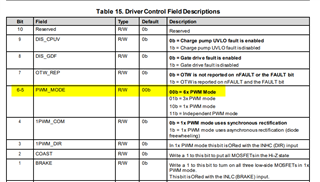Other Parts Discussed in Thread: DRV8323, DRV8353
Tool/software:
Hi,
I am trying to run a 3-phase BLDC motor using the DRV8323 driver in 1xPWM mode with a Hall effect sensor. I am also using the Nucleo WB55RG board to generate a 20kHz PWM signal.
The motor is spinning, but there is audible noise, which decreases only at a 50% duty cycle. Additionally, the motor speed does not vary with changes in the duty cycle.
INHC= HIGH
INLC = HIGH
INHA = PWM
INLA,INHB,INLB = HALL sensor
ENABLE = HIGH



